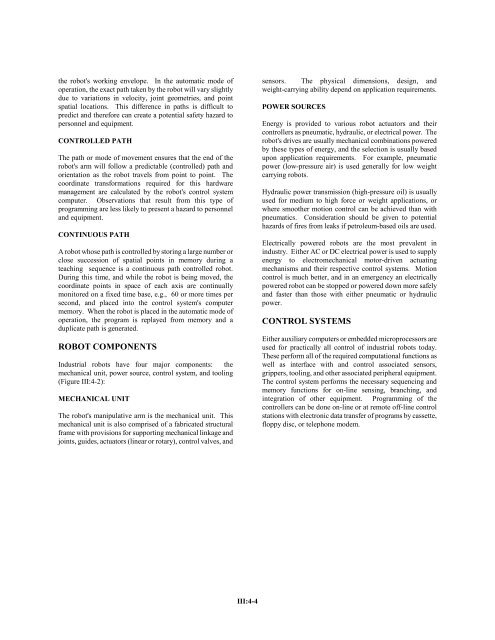Technical Manual - Section 3 (Safety Hazards)
Technical Manual - Section 3 (Safety Hazards)
Technical Manual - Section 3 (Safety Hazards)
You also want an ePaper? Increase the reach of your titles
YUMPU automatically turns print PDFs into web optimized ePapers that Google loves.
the robot's working envelope. In the automatic mode of<br />
operation, the exact path taken by the robot will vary slightly<br />
due to variations in velocity, joint geometries, and point<br />
spatial locations. This difference in paths is difficult to<br />
predict and therefore can create a potential safety hazard to<br />
personnel and equipment.<br />
CONTROLLED PATH<br />
The path or mode of movement ensures that the end of the<br />
robot's arm will follow a predictable (controlled) path and<br />
orientation as the robot travels from point to point. The<br />
coordinate transformations required for this hardware<br />
management are calculated by the robot's control system<br />
computer. Observations that result from this type of<br />
programming are less likely to present a hazard to personnel<br />
and equipment.<br />
CONTINUOUS PATH<br />
A robot whose path is controlled by storing a large number or<br />
close succession of spatial points in memory during a<br />
teaching sequence is a continuous path controlled robot.<br />
During this time, and while the robot is being moved, the<br />
coordinate points in space of each axis are continually<br />
monitored on a fixed time base, e.g., 60 or more times per<br />
second, and placed into the control system's computer<br />
memory. When the robot is placed in the automatic mode of<br />
operation, the program is replayed from memory and a<br />
duplicate path is generated.<br />
ROBOT COMPONENTS<br />
Industrial robots have four major components: the<br />
mechanical unit, power source, control system, and tooling<br />
(Figure III:4-2):<br />
MECHANICAL UNIT<br />
The robot's manipulative arm is the mechanical unit. This<br />
mechanical unit is also comprised of a fabricated structural<br />
frame with provisions for supporting mechanical linkage and<br />
joints, guides, actuators (linear or rotary), control valves, and<br />
sensors. The physical dimensions, design, and<br />
weight-carrying ability depend on application requirements.<br />
POWER SOURCES<br />
Energy is provided to various robot actuators and their<br />
controllers as pneumatic, hydraulic, or electrical power. The<br />
robot's drives are usually mechanical combinations powered<br />
by these types of energy, and the selection is usually based<br />
upon application requirements. For example, pneumatic<br />
power (low-pressure air) is used generally for low weight<br />
carrying robots.<br />
Hydraulic power transmission (high-pressure oil) is usually<br />
used for medium to high force or weight applications, or<br />
where smoother motion control can be achieved than with<br />
pneumatics. Consideration should be given to potential<br />
hazards of fires from leaks if petroleum-based oils are used.<br />
Electrically powered robots are the most prevalent in<br />
industry. Either AC or DC electrical power is used to supply<br />
energy to electromechanical motor-driven actuating<br />
mechanisms and their respective control systems. Motion<br />
control is much better, and in an emergency an electrically<br />
powered robot can be stopped or powered down more safely<br />
and faster than those with either pneumatic or hydraulic<br />
power.<br />
CONTROL SYSTEMS<br />
Either auxiliary computers or embedded microprocessors are<br />
used for practically all control of industrial robots today.<br />
These perform all of the required computational functions as<br />
well as interface with and control associated sensors,<br />
grippers, tooling, and other associated peripheral equipment.<br />
The control system performs the necessary sequencing and<br />
memory functions for on-line sensing, branching, and<br />
integration of other equipment. Programming of the<br />
controllers can be done on-line or at remote off-line control<br />
stations with electronic data transfer of programs by cassette,<br />
floppy disc, or telephone modem.<br />
III:4-4
















